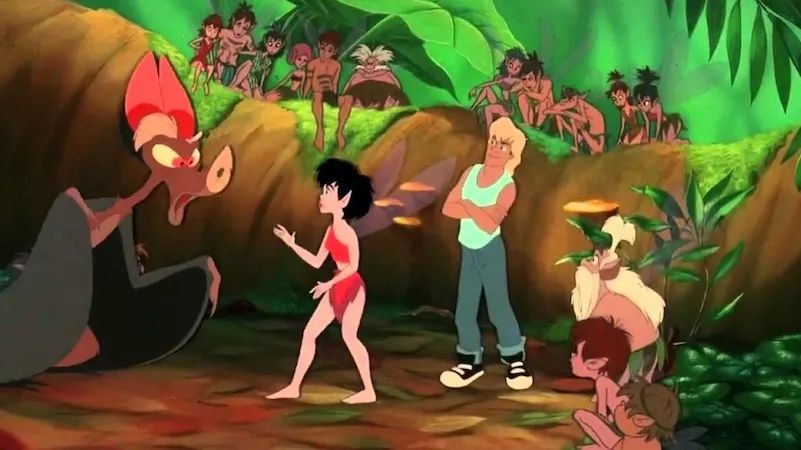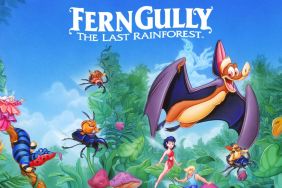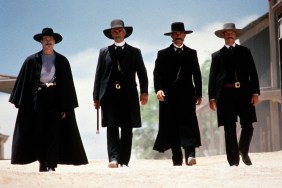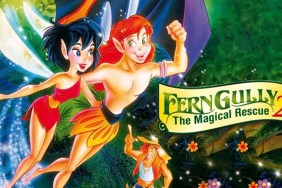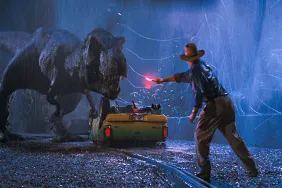After Captain Planet and the Planeteers tried to make being environmentally conscious cool nearly two years earlier, it was time to inform the masses and bring the plight of the rainforests to the big screen. The film was an attempt to make kids care about nature, spread a message, and do an animated feature based on bedtime stories that Diana Young told her kids back in the ‘70s. It took a long time to get here, but even thirty years later, most can still recall the magic of FernGully: The Last Rainforest.
FernGully is about a particular rainforest in Australia – even if no one in the movie has an appropriate local accent – and the creatures that live in it. The main character, Crysta (Samantha Mathis), is a fairy, who lives with others of her kind and their animal friends. Their home is soon threatened by a machine that is cutting down trees and an ancient villain named Hexxus, but before all of that the audience has to meet Zak, a young logger who is accidentally shrunk down and gets to know the denizens of the forest, seeing their magic firsthand. It’s a solid setup for a 76-minute long animated feature, just throw in a couple of memorable characters and a few decent songs – an instant classic. Okay, we won’t go that far. FernGully is good, but not great. The more interesting parts are what people forgot, hadn’t seen when they were younger, or didn’t know about its production.
This is a movie that wouldn’t have been possible without the success of The Little Mermaid helping to re-spark a love of animation and securing its place on the big screen. Being that the 1989 hit was a Disney film is noteworthy, considering the troubles FernGully had with the larger studio. Bill Kroyer, the project’s director, and Jim Cox, its writer, were both veterans of Disney and managed to poach several young artists under the nose of Jeffrey Katzenberg, who was the head of Disney’s animation division. This was after a deceptive tour of the studio while wearing someone else’s nametag.
It’s no wonder that Katzenberg wasn’t pleased and went as far as to outbid Kroyer Films on two of their potential office space locations. He also tried to convince actor Robin Williams not to be in FernGully, since he was doing a little film for them called Aladdin in the same year. Williams refused to hear the argument, however, and the smaller studio was eventually set up in an old local brewery.
FernGully wasn’t going to be able to compete with Disney on quite the same level. Even though animation was stepping back into the limelight, it was still hard to get general audiences to watch most features in the genre that didn’t have the Disney name attached to them. The work would have to speak for itself, and that meant that the presentation needed to be fantastic. Kroyer was willing to go the distance to make that happen and was already looking at blending CGI and traditional art before many had embraced the method.
The team spent seven weeks exploring Australia’s rainforests while the animators drew sketches and crafted the environments for the film based on the real locations, opting not to do a more made-up heightened version for this piece of nature. They were especially inspired by the glowing mushrooms, which helped to bring their vision to life. This attention to detail ensured that most viewers found the visuals incredibly pleasing.
Then it came down to characters and voices. The designs themselves were great in most places, like Crysta with her expressive performance, Goanna, the colorful monitor lizard, and the deliciously evil villain, Hexxus, who had to be toned back down to make sure it didn’t horrify children. Other characters, however, are considered to be a bit boring and underutilized, where it seems a few are there simply for cameos – such as Cheech Marin and Tommy Chong as Beetle Boys – or don’t get the opportunity of a full story arc, like Pips (Christian Slater).
Thankfully, the voice acting is decent here with most of the cast, but it truly stands out in a few places. Many viewers will remember the character of Batty Koda, a lab experiment who had been shocked one too many times and was brought to life by the maniacal chaos that was Robin Williams in his first animated role. Some might find this performance less refined and a tad bit annoying, but there’s no lack of energy. He isn’t just zany, Batty raps too! Though the role of Batty was originally supposed to be smaller, Williams’ work was incredibly appreciated and he supposedly recorded almost 14 hours’ worth of material for the film.
Tim Curry is also excellent as Hexxus, giving the baddie some range and performing his memorable song, “Toxic Love,” ranking quite high as villains go for many kids who saw this one in theaters. In fact, the only character that doesn’t work for me is Zak, our human protagonist, played by Jonathan Ward. This actor is mostly known for Charles in Charge as well as Mac and Me, but whether it’s his performance or the dialogue, little charm or emotion comes through in the lines. He feels like one of the small bumps in the road toward this being a much better film and makes many question if there needed to be a human element in the main cast at all.
The music also adds something extra, even if not immediately recognizable. Other than the two instances mentioned above, there is also a song called “If I’m Gonna Eat Somebody (It Might As Well Be You),” performed by Tone Loc, gracing us with his beautiful baritone voice, containing lyrics written by Jimmy Buffet. There are other pieces performed by Sheena Easton, Raffi, and Elton John, all backed up by an excellent score from Alan Silvestri. It’s a varied soundtrack that helps elevate the film in spots and if someone finds them groan-worthy, most of these numbers are over relatively quick.
The odd parts of the plot and pacing issues stick out a bit more now watching it years later. Hexxus and the Leveler make for a solid conflict, but that’s when everyone remembers that there was a doomsday device set on their home. However, give the film credit for an ending that still holds up decently and doesn’t allow Zak to just stay in this new utopia with the girl he was falling for.
FernGully also has an odd sexual vibe, showing Zak and Crysta quickly falling for each other, while Pips gets jealous. There’s also the odd blue hand scene that many interpret as some form of forest or spirit sex, even though Zak had to hide the humans’ intentions to give himself more time to score. In the songs, Tone Loc performs an anthem about eating someone in a sultry manner while Hexxus uses the word ‘horny’ in his big ballad, and as soon as Zak is gone back to his world Crysta seems to be playfully flirting with Pips again.
In a less subtle message, many of the lines directly reference the destruction humans cause, the harm they do, and how these acts have harmed nature and the planet as a whole. In some ways, this feels more excusable because most of it serves the plot, especially the secondary theme of animal experimentation with Batty. But even though producer Wayne Young said he wanted to be blatant and not preachy, it certainly feels like that in several parts. FernGully was even shown at the UN General Assembly in 1992 on Earth Day, just in case the environmental message shining through wasn’t clear.
FernGully is a film that is still remembered by many fans, even if most people never played the PC game, which is just a computerized coloring book, or saw the 1998 sequel, FernGully 2: The Magical Rescue, which was released as a direct-to-video follow-up without Zak or any of the original voice actors. The movie came up in conversation a good bit also being compared to James Cameron’s Avatar, even if as a joke. Still, years later, there are many who remember the movie that tried to inspire kids to make a difference, that wanted to stand up and take a spot next to Disney, and that tried to show us all a bit of magic in the world.
